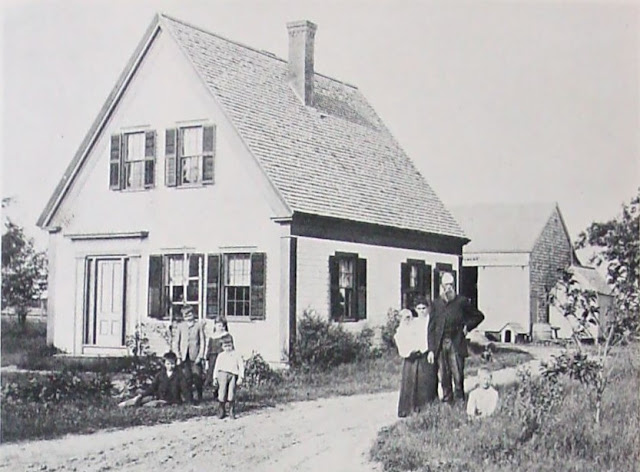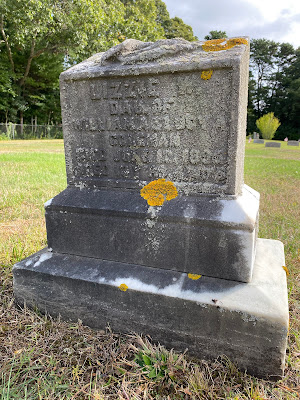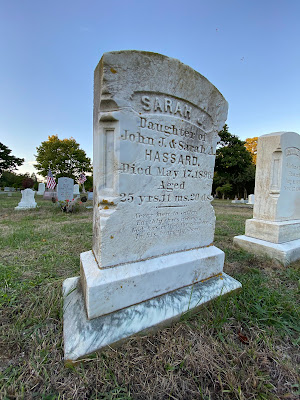
The travel and lifestyle blog of In My Footsteps Podcast host and author Christopher Setterlund. Discovering and sharing the best of today and yesterday. Beautiful and inspiring places to visit now, along with incredible stories of times gone by. From Cape Cod to New England and beyond, from present-day, to some classic 1980's nostalgia, to days long gone by. There is something for everyone here much like with the podcast.
Friday, October 28, 2022
Sunday, October 23, 2022
Saturday, October 15, 2022
Cape Cod History - What Happened to Thomas Powers?
In the early morning hours of Thursday, April 14, 1898, James Jennings was heading out of his Sandwich, Massachusetts home on his way to work. Jennings spotted flickering light coming from inside his neighbor James Keenan’s stable. Curious, Jennings walked over and peered in through a window. What he saw was something of indescribable horror. The light was fire and it was consuming a human body.
Jennings burst into the stable and beat the flames out. It was far too late. The young man was dead and his body was nearly charred beyond recognition. He was Thomas Powers who had been working for Keenan as a stableman. How had he ended up in such a condition?
 |
| A similar stable to Keenan's(John L. Hildreth) |
A further inspection of the scene was performed when State Detective Sim Letteney and Sheriff Eugene Haines were called to the scene. Though Powers’ clothes had been almost entirely consumed by the fire the investigators found the metal hooks of his suspenders by his feet. It appeared as though someone had tried to remove his pants before he had caught fire.
Word of the horrific scene at Keenan’s stable quickly spread around Sandwich and beyond. It was like nothing that Cape Cod had seen before. Powers’ body was eventually removed from the stable with an autopsy scheduled for later in the week.
Rather quickly it became apparent that Powers had not been alone the previous night. Detective Letteney and Sheriff Haines spoke with half a dozen witnesses who said Powers had been in the barn with at least two other persons. The investigators were able to ascertain that whatever happened to Powers likely occurred around midnight.
Several questions were at the forefront. Who was with Thomas Powers the night before? How did Powers meet his end? Was the fire the cause of his death, or an attempt to cover up the true cause? The answer to the first question came shortly thereafter.
Those interviewed told the investigators that Powers had been hanging out with four men the previous night. They were identified as Philip Smith, Eugene Allen, Eben Battles, and Allen Webster.
Detective Letteney interviewed Eugene Allen first. Allen admitted to being a part of the group at Keenan’s stable the night before. He said the five young men had all been drinking heavily. In fact, Webster and Battles were so inebriated that Allen had to walk them home. The three men left Thomas Powers and Philip Smith in the stable.
Letteney sought out Philip Smith for an interview. Smith also admitted to being with the group the previous night, drinking heavily. However, he said he had passed out in the office around ten. The fire had awakened him as it began to creep its way into the office. Smith claimed to have thrown water on the fire and called out to Powers. Not hearing anything he passed out again. Upon awakening, Smith said he simply walked home.
The stories of Allen and Smith did not seem to match up, especially with the evidence that Letteney and Haines had already collected. Legend has it that Detective Letteney did in fact uncover the truth about what happened to Thomas Powers that night in 1898. So why is this case still classified as unsolved?
Detective Letteney brought his evidence to District Attorney Andrew Jennings of Fall River, no relation to the man who had found Thomas Powers’ body. At the time of the investigation, it was reported that Jennings had ordered the case to be further investigated. The problem was that Jennings was far more interested in a case he was pursuing that involved Alicia LeBau Berger. She was the daughter of Cornelius Vanderbilt who was the richest man in the United States. To Jennings that was more important than the potential murder of a poor Irish boy from Cape Cod. Detective Letteney had to do it himself.
 |
| Barnstable County Court House in the early 1900s. |
The investigation was brought before Judge Frederick Swift at Barnstable District Court on April 15, 1898. Letteney was not a trained attorney and therefore was at a huge disadvantage when it came to presenting a case before a grand jury. Although Philip Smith was never officially named a suspect it was believed that he had something to do with Powers’ grisly demise.
Letteney did the best he could to present a compelling case. He brought twenty-two witnesses before a grand jury. Nearly the entire day was spent individually examining them. Unfortunately, much of the evidence was circumstantial and the grand jury chose not to indict Philip Smith or anyone else for that matter. This meant that nobody would end up being held responsible for the death of Thomas Powers. In the end, it was reported that the belief was Powers died from smoke inhalation and subsequently the fire. How exactly the fire was started was never answered.
The outrage on Cape Cod was palpable. If D.A. Jennings had tried the case perhaps a resolution could have been had. The locals saw Jennings as someone who didn’t care about the Cape unless he was being paid by the uber-wealthy Vanderbilt family. They had their chance to extract some revenge in short order.
Mere days before the horrific death of Thomas Powers Cape Cod’s congressional representative, John Simpkins, died. D.A. Jennings quickly announced his candidacy for the open spot. The Republican party caucus took place a few weeks later. It was here that Jennings got his comeuppance. He received no support from Cape Cod and finished dead last out of all of the prospective candidates.
Jennings did not run for district attorney again. He also promised to run again for Congress but that also did not materialize. One interesting twist to the Jennings saga came during the May 31, 1898, special election for the Simpkins seat. One lone person from Cape Cod gave Jennings a write-in vote. It leads to speculation as to whether that write-in vote came from Thomas Powers’ murderer who never was apprehended partially due to the lax attitude of Jennings.
In the end, young Thomas Powers' death remains unsolved. Was he murdered? Was it simply an accident? Was Philip Smith at fault? Or was it someone else? Sadly that answer will likely never come. Regardless of who was at fault, it was a horrific way for someone’s life to end.
----------------------------------------------------------------
Previous Blog Posts:
Friday, October 14, 2022
In My Footsteps Podcast Episode 89: Bathsheba Spooner's Colonial-era Murder for Hire, My Funniest Speeding Ticket, Halloween in the 1980s, Fastest Canceled TV Shows(10-13-2022)
Saturday, October 8, 2022
Friday, October 7, 2022
Saturday, October 1, 2022
Cape Cod History: The Tragic Obsession Murders of Lizzie Coleman and Sadie Hassard
The term murder-suicide is sadly something that is heard far too often in the 21st century. The idea of a person murdering one, or more, people before ending their own lives is both selfish and cowardly. Killing oneself rather than facing the consequences leaves the families unable to properly achieve closure after such a heinous act.
Unfortunately in many of these cases, there are warning signs, some quite blatant, that go unnoticed, or worse, unreported. In the end, it leaves the victims’ families with the same question: could the tragedy have been prevented?
Murder-suicides and unreported threats are sadly not only a present-day issue. Nearly 130 years ago the quiet peninsula of Cape Cod saw two unbelievably tragic cases within a span of fewer than twelve months. Both crimes shook the Cape to its core and only after the fact did it become clear that lives could have been saved if the warning signs had been heeded.
The stories of Osterville’s Lizzie Coleman and Brewster’s Sadie Hassard are similar but different. Both have the sad murder-suicide label. Both came down to jealousy. As stated above, unfortunately, there were warning signs that could have prevented both crimes.
 |
| Lizzie Coleman(3rd from left), and her family outside of their Osterville home. About 1890, she would have been roughly 9 years old. |
It began in Osterville at the end of 1894 when an infatuation was born. German laborer Henry Ledtke, who had been working for a few years on S.S. Leonard’s farm, spotted William and Lucy Coleman’s daughter Lizzie for the first time. Ledtke was a man over forty with a wife and three children back in Germany, Lizzie was thirteen and not yet in high school.
Ledtke’s obsession with Lizzie grew slowly. He began spending more and more time at the Coleman house, on the corner of Main Street and West Barnstable Road, trying desperately to woo the affection of the girl nearly thirty years his junior. The courtship also included numerous gifts given to Lizzie. During this time Lizzie was seen in the company of Eben Harding, the literal boy next door, quite often. The powder keg was soon lit.
As time passed and Ledtke noticed Lizzie and Eben’s budding relationship he grew wild with jealous rage. It was in May 1895 that Ledtke was told by Mr. Coleman to not come near his house or his daughter anymore. When his request that all of the gifts he had given Lizzie be returned was denied that was the last straw.
Ledtke made threats against the entire Coleman family, brazenly admitting to Lizzie that he planned on killing her. Sadly she did not tell her father of the danger. Initially, Ledtke’s plan was to kill both Lizzie and Eben after church on Sunday June 9th. He even suggested a shortcut home to the young couple which would have led them deep into the Osterville woods where he would have ambushed them. When they refused Ledtke devised a blunter scheme that unfolded early the following day.
At 8:30am on Monday June 10th Lizzie walked to school with her two brothers when Ledtke struck. In broad daylight on a public street, he approached Lizzie brandishing a revolver. The first shot grazed her face while two shots missed her brothers. The three turned and ran but Ledtke pursued. He fired a shot that struck Lizzie in the back of the head, killing her instantly. Ledtke then turned the gun on himself. Both murderer and victim lay next to each other in the middle of the street. Incredibly Mr. Coleman had been contemplating alerting the police about Ledtke’s threats on Monday. He never got the chance.
 |
| Lizzie Coleman's grave at Hillside Cemetery in Osterville. |
The outbreak of grief and unimaginable sadness was immediate. Lizzie’s funeral was held the day after at the Osterville Baptist Church on Main Street. Her friends from school sang hymns while surrounding her casket. The situation was made all the worse by the fact that Lizzie Coleman’s murder likely could have been stopped if someone had contacted the authorities earlier. She was laid to rest at Hillside Cemetery on Old Mill Road in Osterville.
342 days later, twenty miles away, with the tragic murder of Lizzie Coleman still fresh in the minds of Cape Codders, a similar story unfolded.
The story of Sarah 'Sadie' Hassard is like the other side of the same coin. The main difference between her story and Lizzie’s is the belief reported at the time that Sadie and her killer were at some point romantically linked.
Sadie and Frederick Alexander both lived in Brewster. She was a pretty and well-liked woman of twenty-five. He was said to be a relatively average young man working odd jobs around town at spots like local cranberry bogs. The pair became a couple with the thought being that they intended to get married at some point. It seemed like a perfect story of young love.
Sometime early in 1896, there was a dissolution of the relationship. Reports at the time said that although Sadie didn’t have eyes for another she had grown tired of Frederick. The young man grew angry and jealous despite Sadie not starting another relationship.
The impact was immediate as Frederick began making threats against her and her family which consisted of parents and four sisters. The nature of the threats was not revealed at the time. However, in a sad parallel to Lizzie Coleman’s case, the family refused to report the threats to the authorities for fear of unwanted notoriety. It was a costly mistake.
On the morning of Sunday, May 17, 1896, Sadie and one of her younger sisters were at home on Lower Road in Brewster. She had been living with elderly Reverend Thomas Dawes for the previous two years, she was likely his caretaker as he was seventy-eight years old at the time. The morning church services were just beginning at the Unitarian Church a few hundred yards away on Main Street(Rt. 6A). As Reverend Dawes gave his opening prayer tragedy was unfolding.
Frederick Alexander went to Sadie’s residence with malice on his mind and a revolver in his hand. He found the doors locked and attempted to enter through a window. Although he was not able to enter the house he managed to grab Sadie and drag her out through the window. She ran out of the yard through the front gate, narrowly missing being shot by Frederick.
The sound of the shot startled the churchgoers at the Unitarian Church. Sadie attempted to flee to her parents' house further down Lower Road. Three more shots followed as Frederick gave chase. Sadie fell after being hit and before she could even move Frederick caught up to her, pressed the gun to her head, and fired the final shot. He immediately fled south as the church members approached finding young Sadie Hassard dead.
After the initial shock of finding Sadie's body, the search was on. Chairman of Selectmen of Brewster, John Clark, and Deputy Sheriff Alfred Crocker, put together the search as it seemed to be apparent to those in the know that Frederick Alexander was the culprit.
 |
| Sadie Hassard's gravestone. |
The search party headed south, eventually crossing into what is present-day Sweetwater Forest campground. Along the shore of Snow’s Pond, Frederick’s hat was found. Inside it was the murder weapon and twenty-five unused bullets. There was no sign of the killer along the water’s edge but a boat was sent for and the pond was searched. Several passes found nothing. The search persisted and eventually, the body of Frederick Alexander was found about one hundred feet from shore in five feet of water. He had taken his own life.
Once pulled to shore his person was searched. A bottle of strychnine was found. Also in his pocket was a note evidently written earlier in the day. In the note, Frederick said he planned on killing Sadie and would not be taken alive. He ended with an ominous threat that if he was cornered he would take others with him. This meant that if the concerned churchgoers had arrived a few moments earlier there could have been more losses of life.
The outpouring of grief was immense in the quiet town of Brewster. Sadie Hassard’s funeral was held at the Baptist Church on Main Street on Wednesday, May 20, 1896. The church was overflowing with people from all over Cape Cod. Reverend Dawes, beside himself with sadness, gave a heartfelt prayer for Sadie’s soul, and the wounded hearts of her family and the town.
 |
| The Hassard house foundation at the head of the Eddy Bay Trail in Brewster. |
Sadie Hassard was laid to rest at the Brewster Cemetery on Lower Road. A few hundred yards east of the cemetery, where the Hassard family home stood, is now the Eddy Bay Trail conservation area. The stone remains of the home’s foundation still stand as a solemn link back to a sad and tragic event in Brewster’s history that possibly could have been prevented if only the threats had been reported.
Lizzie Coleman and Sadie Hassard both had long lives ahead of them. Both of these young ladies had their flame cruelly snuffed out by jealous men. It is important to remember that there were warning signs in both cases. If you or someone you know is in a similar situation to Lizzie and Sadie before their untimely murders please reach out to the proper authorities.
--------------------------------------------------------------------------------
Previous Blog Posts:




